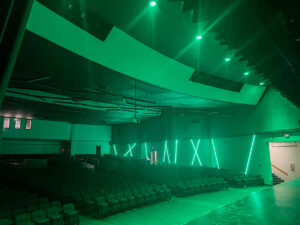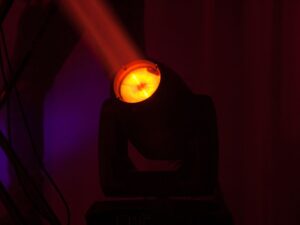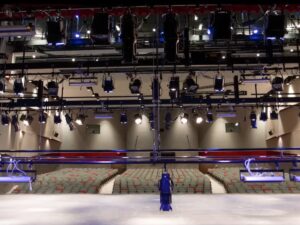Stage lighting has undergone a remarkable transformation over the years, transitioning from conventional incandescent bulbs to the powerful and energy-efficient LED (Light Emitting Diode) technology. The development of LED stage lighting revolutionized the way performances are illuminated, providing greater control, flexibility, and unlimited creative possibilities.
In this article, we overview the many benefits modern LED stage lighting provides compared to incandescent/halogen and older generation LED technologies.
Benefits of LED Stage Lighting
Versatility and Control

RGBW lighting allows for dynamic designs throughout the auditorium.
LED stage lighting has unleashed the possibilities available to lighting designers (LD). From the lighting console, an LD can control fine-tuned color selection, light intensity, adjustable zoom/beam angle, auto focus, and, depending on the fixture, additional features such as the panning and tilting of moving heads and the switching of gobo effects. Cyclorama lighting can turn a white background into a realistic sunset with dynamic reds, yellows, oranges, and pinks, or the gentle blue undulations of being ‘under the sea’. The improved brightness and color rendering of LEDs with the expansion of DMX controllability allows for color changing house, accent, and strip lighting that expands the stage into the audience and allows for dazzling animated scenes throughout the entire auditorium.
Light Quality and Color Selection
In the late 2000’s through mid-2010’s when LED stage lighting was emerging in the market, many lighting designers preferred using halogen lighting even with the energy and maintenance benefits of LEDs. They claimed that traditional lighting provided superior white light, more intense colors, and better color mixing. These were valid arguments as the blueish tinge of LED ‘white light’ often left talent looking unnatural, and the range for bright well-mixed colors from LED lights was limited due to the layout of individual red, green, and blue diodes on a light source.
However, rapid developments in LED stage lighting technology in the past decade have not only remedied the drawbacks of older generation LED technology, but squarely set modern LED stage lighting as, by far, the superior choice. New fixtures produce not only high-quality, but highly selectable ‘white’ light through the addition of amber, lime, and/or other LED diodes. Additionally, advancements in LED output, automated zoom, and lenses provide intense and evenly distributed colors close to the source, at distance, and everywhere between.
Energy Efficiency

Energy savings are enjoyed when a single LED fixture has more capability than 4 incandescent fixtures.
LED stage lighting is highly energy-efficient, consuming significantly less power than incandescent lighting. LEDs convert almost all the energy they consume into light, whereas incandescent bulbs waste a substantial amount of energy as heat. Furthermore, a single RGBW (red-green-blue-white) LED light fixture can produce the same colors which four individual incandescent fixtures shining red, green, blue, and white light, respectively, were required. This means lighting designers can have brighter lighting from fewer light sources, with significantly reduced energy utilization when switching from incandescent to LED. Savings can still be experienced when transitioning from early-generation to modern fixtures.
Heat Emission
Incandescent lighting generates a significant amount of heat which affects the comfort of performers as well as the integrity of props, costumes, and makeup. Furthermore, a warmer theater requires more intense HVAC operation which drives up both system noise during performances and energy usage.
As stated previously, LED lighting produces very little heat. Performers are more comfortable, HVAC runs quieter, and extra utility savings are enjoyed.
Maintenance

With the heightened durability of LED fixtures, many theaters are removing catwalks and adding motorized rigging for safety and ease of moving fixtures.
Except for relocating and refocusing non-autofocusing LED fixtures for different performances, very little upkeep or maintenance is required for modern LED stage fixtures. With the elimination of the constant need to replace gels and lamps, many modern theaters are removing catwalks opting instead for movable rigging options whether via counterweighted or motorized systems.
Longevity
LED bulbs have an impressive lifespan, lasting up to 50,000 hours or more, whereas incandescent bulbs typically last for a few thousand hours. For example, the top-of-the-line halogen ETC Source Source Four HID Zoom fixture boasted a 12,000-hour lifespan which was truly impressive for the technology. The modern version, the Source Four LED Series 2, provides 54,000-hour lifespan of full RGBW lighting.
For most K-College applications, modern LED stage lighting fixtures will provide at least a quarter-century of high-quality illumination.

